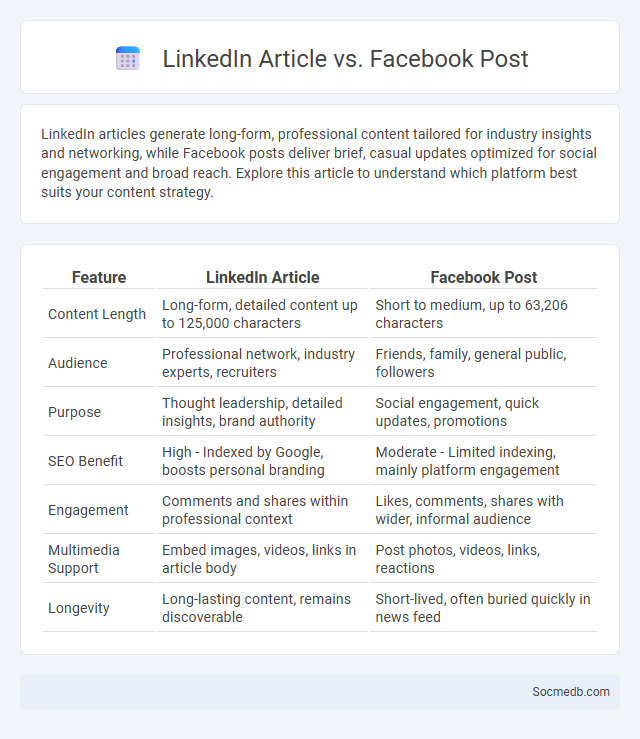
Photo illustration: LinkedIn Article vs Facebook Post
LinkedIn articles generate long-form, professional content tailored for industry insights and networking, while Facebook posts deliver brief, casual updates optimized for social engagement and broad reach. Explore this article to understand which platform best suits your content strategy.
Table of Comparison
| Feature | LinkedIn Article | Facebook Post |
|---|---|---|
| Content Length | Long-form, detailed content up to 125,000 characters | Short to medium, up to 63,206 characters |
| Audience | Professional network, industry experts, recruiters | Friends, family, general public, followers |
| Purpose | Thought leadership, detailed insights, brand authority | Social engagement, quick updates, promotions |
| SEO Benefit | High - Indexed by Google, boosts personal branding | Moderate - Limited indexing, mainly platform engagement |
| Engagement | Comments and shares within professional context | Likes, comments, shares with wider, informal audience |
| Multimedia Support | Embed images, videos, links in article body | Post photos, videos, links, reactions |
| Longevity | Long-lasting content, remains discoverable | Short-lived, often buried quickly in news feed |
Introduction to Social Media Content Types
Social media content types include images, videos, stories, live streams, and text posts, each designed to engage diverse audiences across platforms like Instagram, Facebook, Twitter, and TikTok. Visual content such as photos and videos drives higher engagement rates, while interactive formats like polls and live streaming foster real-time communication. Understanding these content types helps marketers optimize reach, boost brand awareness, and enhance user interaction.
Key Differences Between LinkedIn Articles and Facebook Posts
LinkedIn articles provide in-depth, professional content designed to establish your expertise and engage industry peers, while Facebook posts emphasize shorter, more casual updates aimed at broader, social interactions. LinkedIn supports long-form publishing with detailed analytics on readership and engagement, whereas Facebook favors multimedia-rich posts with immediate reactions and comments from a diverse audience. Your choice depends on whether you want to build a professional brand or foster personal connections through social media.
Audience Demographics: LinkedIn vs Facebook
LinkedIn attracts a professional audience primarily aged 25-34, with a strong presence of high-income earners and decision-makers, making it ideal for B2B marketing and career networking. Facebook has a broader demographic range, including younger users aged 18-24 and older adults over 50, offering a more diverse audience for B2C engagement and community building. Understanding these audience demographics helps you tailor your social media strategy for optimal reach and impact.
Content Purpose and Professionalism
Social media platforms serve varied content purposes, ranging from brand awareness and customer engagement to thought leadership and direct sales. High-quality, professional content enhances credibility, fosters trust, and drives meaningful interactions with target audiences. Consistent branding combined with strategic messaging ensures content aligns with business goals and resonates effectively across social channels.
Length and Format Comparison
Social media platforms vary significantly in ideal post length and format, with Twitter favoring concise tweets limited to 280 characters, while Instagram emphasizes visual content like images and short videos paired with brief captions. Facebook supports a mix of text, images, videos, and live streams, allowing longer posts up to 63,206 characters, enabling deeper engagement and storytelling. LinkedIn prioritizes professional content with posts that balance concise text and multimedia, typically up to 3,000 characters, often formatted as articles or infographics to maximize reach among industry audiences.
Engagement and Reach Potential
Maximizing social media engagement involves creating compelling content that resonates with target audiences, encouraging likes, comments, and shares to boost visibility. Effective use of hashtags, timing posts strategically, and interacting with followers enhance reach potential by tapping into diverse networks and algorithms favoring active user participation. Higher engagement rates amplify brand awareness and drive organic growth, solidifying social media presence across platforms like Instagram, Facebook, and Twitter.
SEO Benefits for Articles on Each Platform
Social media platforms like Facebook, Twitter, LinkedIn, and Instagram enhance SEO benefits by increasing article visibility, driving targeted traffic, and generating quality backlinks. Sharing your content on these networks boosts engagement metrics such as likes, shares, and comments, signaling search engines about its relevance and authority. By optimizing your articles for platform-specific algorithms and audience behavior, you improve your online presence and organic search rankings.
Visual Elements: Images, Videos, and Graphics
Images, videos, and graphics are essential visual elements in social media that boost engagement and enhance content appeal. High-quality visuals increase user interaction by up to 94%, making them crucial for brand recognition and message retention. Incorporating diverse multimedia formats such as infographics, short videos, and carousel images accelerates audience attention and drives higher sharing rates.
Analytics and Performance Tracking
Social media analytics provide deep insights into audience behavior, engagement rates, and content performance, enabling you to refine your marketing strategies effectively. Utilizing tools like Google Analytics, Facebook Insights, and Twitter Analytics allows for real-time tracking of key performance indicators (KPIs) such as reach, impressions, click-through rates, and conversion metrics. By analyzing these data points, your campaigns can be optimized to maximize ROI and drive sustained growth across platforms.
Choosing the Right Platform for Your Content Strategy
Selecting the ideal social media platform depends on your target audience demographics, content type, and engagement goals. Instagram excels in visual storytelling and influencer marketing, while LinkedIn offers B2B networking and professional content opportunities. Understanding platform-specific algorithms and user behavior maximizes content reach and conversion rates.
 socmedb.com
socmedb.com